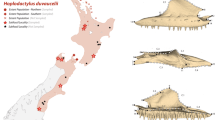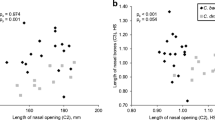Abstract
The extinct taxon Dasypus bellus has long been considered identical to the extant Dasypus novemcinctus osteologically when disregarding allometric differences. In this study, we undertake a preliminary investigation into this extinct taxon and an extant relative D. novemcinctus, by comparing the calcanea of these two dasypodids. Clear osteological differences are observed including a mediolaterally-reduced facet region, an anteriorly-shortened calcaneal head, a reduced peroneal process, and a curved and dorsoventrally-shortened calcaneal foot in D. bellus. Such characters are not allometric and likely correlate to distinct behavioral differences. Specifically, we suggest that D. novemcinctus maintains a more fossorial lifestyle, while the larger D. bellus was likely more terrestrial, with potentially little digging behavior. Such lifestyle differences could not only explain the osteological differences present, but also why fossils of D. bellus have been recovered farther north than the present range of D. novemcinctus. Fossils of Dasypus may need to be re-evaluated to determine how these two taxa relate temporally and geographically, which may have further implications regarding some past interpretations and provide new details on the behavior and potential relationships between these (and other) xenarthrans.










Similar content being viewed by others
References
Audubon JJ, Bachman J (1854) Quadrupeds of North America. Vol 3. George R. Lockwood, New York, 349 p
Bassarova M, Janis CM, Archer M (2009) The calcaneum–On the heels of marsupial locomotion. J Mammal Evol 16:1–23
Biewener AA (1989) Mammalian terrestrial locomotion and size. BioScience 39:776–783
Biewener AA (1990) Biomechanics of mammalian terrestrial locomotion. Science 250:1097–1103
Biewener AA (2005) Biomechanical consequences of scaling. J Exp Biol 208:1665–1676
Blackburn TM, Gaston KJ, Loder N (1999) Geographic gradients in body size: a clarification of Bergmann’s Rule. Divers and Distrib 5:165–174
Bookstein FL (1991) Morphometric Tools for Landmark Data: Geometry and Bioogy. Cambridge University Press, Cambridge, 435 p
Campione NE, Evans DC (2011) Cranial growth and variation in edmontosaurs (Dinosauria: Hadrosauridae): implications for latest Cretaceous megaherbivore diversity in North America. PLoS ONE 6(9):e25186
Cardini A, O’Higgins P (2004) Patterns of morphological evolution in Marmota (Rodentia, Sciuridae): geometric morphometrics of the cranium in the context of marmot phylogeny, ecology and conservation. Bio J Linn Soc 82:385–407
Carrano MT (1997) Morphological indicators of foot posture in mammals: a statistical and biomechanical analysis. Zool J Linn Soc 121:77–104
Carrano MT (1998) Locomotion in non-avian dinosaurs: integrating data from hindlimb kinematics, in vivo strains, and bone morphology. Paleobiology 24:450–469
Christiansen P (1999) Long bone scaling and limb posture in non-avian theropods: evidence for differential allometry. J Vertebr Paleontol 19(4):666–680
Christiansen P (2002) Mass allometry of the appendicular skeleton in terrestrial mammals. J Morphol 251:195–209
Currie PJ (2003) Allometric growth in tyrannosaurids (Dinosauria: Theropoda) from the Upper Cretaceous of North America and Asia. Can J Earth Sci 40:651–665
Dodson P (1975) Taxonomic implications of relative growth in lambeosaurine dinosaurs. Syst Zool 24:37–54
Eichler SE, Gaudin TJ (2011) New records of the nine-banded armadillo, Dasypus novemcinctus, in southeast Tennessee, and their implications. Edentata 12:7–13
Elewa AMT (ed) (2004) Morphometrics: Applications in Biology and Paleontology. Springer-Verlag, Berlin, Heidelberg, New York, 277 p
Guilday JE, Hamilton HW, Anderson E, Parmalee, PW (1978) The Baker Bluff Cave deposit, Tennessee, and the late Pleistocene faunal gradient. Bull Carnegie Mus Nat Hist 11:1–67
Hoffstetter R (1958) Xenarthra. In: Piveteau J (ed) Traité de Paléontologie. Paris, Masson et Cie, pp 535–636
Hofmann JE (2009) Records of nine–banded armadillos, Dasypus novemcinctus, in Illinois. Trans Ill State Acad Sci 102:95–106
Hulbert RC, Jr., Pratt AE (1998) New Pleistocene (Rancholabrean) vertebrate faunas from coastal Georgia. J Vertebr Paleontol 18(2):412–429
Humphrey S (1974) Zoogeography of the nine-banded armadillo (Dasypus novemcinctus) in the United States. BioScience 24:457–462
Klippel WE, Parmalee PW (1984) Armadillos in North American late Pleistocene contexts. In: Genoways HH, Dawson MR (eds) Contributions in Quaternary Vertebrate Paleontology: A Volume In Memorial To John E. Guilday. Carnegie Mus Nat Hist Spec Pub 8: 149–160
Kurtén B, Anderson E (1980) Pleistocene Mammals of North America. Columbia University Press, New York, 442 p
Layne JN (2003) Armadillo: Dasypus novemcinctus. In: Feldhammer GA, Thompson BC, Chapman JA (eds) Wild Mammals in North America: Biology, Management, and Conservation. The Johns Hopkins University Press, Baltimore, pp 75–97
Letts B, Shapiro B (2010) The recovery of ancient DNA from Dasypus bellus provides new possibilities for investigating late Pleistocene mammal response to climate change. Geophys Res Abstr 12:14443
Letts B, Shapiro B (2012) Case study: ancient DNA recovered from Pleistocene-age remains of a Florida armadillo. In: Shapiro B, Hofreiter M (eds) Ancient DNA: Methods and Protocols. Humana Press, New York, 259 p
Loughry WJ, McDonough CM (2013) The Nine-Banded Armadillo: A Natural History. University of Oklahoma Press, Norman, 344 p
McBee K, Baker RJ (1982) Dasypus novemcinctus. Mammal Spec 162:1–9
McDonald HG, Naples VL (2008) Xenarthra. In: Janis CM, Gunnell GF, Uhen MD (eds) Evolution of Tertiary Mammals of North America: Volume 2, Small Mammals, Xenarthrans, and Marine Mammals. Cambridge University Press, Cambridge, pp 147–160
McNab BK (1980) Energetics and the limits to a temperature distribution in armadillos. J Mammal 61:606–627
Meiri S (2011) Bergmann’s Rule – what’s in a name? Global Ecol Biogeogr 20:203–207
Meiri S, Dayan T (2003) On the validity of Bergmann’s Rule. J Biogeogr 30:331–351
Polly PD, MacLeod N (2008) Locomotion in fossil Carnivora: an application of eigensurface analysis for morphometric comparison of 3D surfaces. Palaeontol Electron 11: 10A, 13p
Rhodes RS II (1984) Paleoecology and regional paleoclimatic implications of the Farmdalian Craigmile and Woodfordian Waubonsie mammalian local faunas. Illinois St Mus Rept Inv 40:1–51
Rincon AD, White RS, McDonald HG (2008) Late Pleistocene cingulates (Mammalia: Xenarthra) from Mene de Inciarte tar pits, Sierra de Perija, western Venezuela. J Vertebr Paleontol 28:197–207
Robertson JS, Jr (1976) Latest Pliocene mammals from Haile XV A, Alachua County, Florida. Bull Florida State Mus Bio Sci Ser 20:111–186
Rohlf FJ (2004a) tpsSuper, superimposition, image unwarping, and averaging, version 1.14. Department of Ecology and Evolution. State University of New York at Stony Brook
Rohlf FJ (2004b) tpsSplin, thin-plate spline, version 1.20. Department of Ecology and Evolution. State University of New York at Stony Brook
Rohlf FJ (2010a) tpsDig2, digitize landmarks and outlines, version 2.16. Department of Ecology and Evolution. State University of New York at Stony Brook
Rohlf FJ (2010b) tpsUtil, file utility program, version 1.46. Department of Ecology and Evolution. State University of New York at Stony Brook
Schubert BW, Graham RW (2000) Terminal Pleistocene armadillo (Dasypus) remains from the Ozark Plateau, Missouri, USA. PaleoBios 20:1–6
Slaughter BH (1961) The significance of Dasypus bellus (Simpson) in Pleistocene local faunas. Texas J Sci 13:311–315
Szalay FS (1994) Evolutionary History of the Marsupials and an Analysis of Osteological Characters. Cambridge University Press, Cambridge, 496 p
Taulman JF, Robbins LW (1996) Recent range expansion and distributional limits of the nine-banded armadillo (Dasypus novemcinctus) in the United States. J Biogeogr 23:635–648
Van Deelen TR, Parrish, JD, Heske, EJ (2002) A nine-banded armadillo (Dasypus novemcinctus) from central Illinois. Southwest Nat 47:489–491
van Heteren AH, MacLarnon A, Rae TC, Soligo C (2009) Cave bears and their closest living relatives: a 3D geometric morphometrical approach to the functional morphology of the cave bear Ursus spelaeus. Slov Kras Acta Carsologica Slovaca 47:33–46
van Heteren AH, MacLarnon A, Soligo C, Rae TC (2012) 3D geometric morphometrical analyses of intraspecific variation in the mandible of Ursus spelaeus from the Alpine region. Braunschw Naturkundliche Schr 11:111–128
Vizcaíno SF, Bargo MS, Fariña RA (2008) Form, function, and paleobiology in xenarthrans. In: Vizcaino SF, Loughry WJ (eds) The Biology of the Xenarthra. University Press of Florida, Gainesville, pp 86–99
Vizcaíno SF, Fariña RA (1997) Diet and locomotion of the armadillo Peltephilus: a new view. Lethaia 30:79–86
Vizcaíno SF, Fariña RA, Mazzetta G (1999) Ulnar dimensions and fossoriality in armadillos and other South American mammals. Acta Theriol 44:309–320
Vizcaíno SF, Milne N (2002) Structure and function in armadillo limbs (Mammalia: Xenarthra: Dasypodidae). J Zool 257:117–127
Vizcaíno SF, Milne N, Bargo MS (2003) Limb reconstruction of Eutatus seguini (Mammalia, Dasypodidae): paleobiological implications. Ameghiniana 40:89–101
Voorhies MR (1987) Fossil armadillos in Nebraska: the northernmost record. Southwest Nat 32:237–243
Webb SD (1974) Chronology of Florida Pleistocene mammals. In: Webb SD (ed) Pleistocene Mammals in Florida. University of Florida Press, Gainesville, pp 5–31
Acknowledgments
We thank Sandra Swift and Blaine Schubert for help with the specimens and discussions involving this manuscript; Jun Ebersole and the McWane Science Center for loaning RMM 6356 for study; Sharon Holte for discussion of ACb-3 cave; and the individuals who collected the material, including “ME” who is listed as having collected RMM 6356 on June 19, 1987. Eric Lynch and Anneke van Heteren both provided help with MorphoJ and analyses. The editor John R. Wible and four anonymous reviewers provided helpful comments and suggestions that greatly improved this manuscript. This research was also supported in part by the National Science Foundation (EAR-0958985).
Author information
Authors and Affiliations
Corresponding author
Electronic supplementary material
Below is the link to the electronic supplementary material.
ESM 1
(DOC 106 kb)
Rights and permissions
About this article
Cite this article
Jasinski, S.E., Wallace, S.C. Investigation into the Paleobiology of Dasypus bellus Using Geometric Morphometrics and Variation of the Calcaneus. J Mammal Evol 21, 285–298 (2014). https://doi.org/10.1007/s10914-013-9239-0
Published:
Issue Date:
DOI: https://doi.org/10.1007/s10914-013-9239-0




